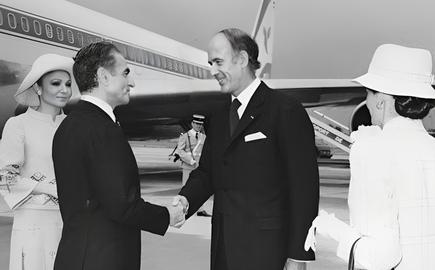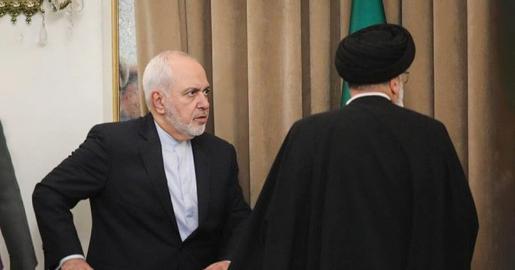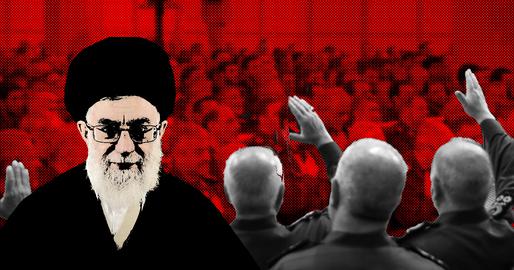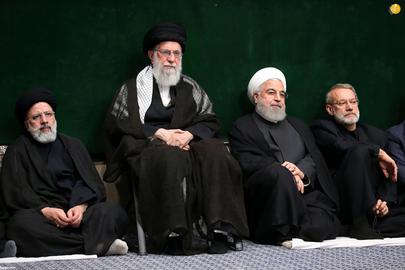One of the lesser-known facts about Ruhollah Khomeini, the founder of the Islamic Republic, is his relationship and his close associates’ with the deputy commander of NATO before the 1979 Islamic Revolution and Heydar Aliyev, who later became the president of Azerbaijan.
Aliyev was reportedly associated with Khomeini during his time as an agent of the Soviet spy organization KGB in the Iraqi city of Najaf.
Hoshang Nahavandi is a familiar name in politics in Iran. Before the revolution, he served as the president of Pahlavi and Tehran universities and, in the final months of the Shah's rule, he was an adviser to the monarch.
Nahavandi left the country after the Shah’s downfall and continued his academic activities.
In his book “Khomeini in Paris,” he presents documents detailing Khomeini's foreign relations, which the Islamic Republic’s current leaders are likely unaware of.
The book endeavors to provide a comprehensive understanding of Khomeini and the days leading up to the revolution by exploring documents, firsthand quotes from individuals associated with the Shah’s government, and interviews with other history actors.
The most significant and substantial portion of the book touches upon the rise of Khomeini's political standing and influence among Iranians during his exile in Najaf and a Paris suburban town.
In Najaf, he received substantial financial support from Lieutenant General Teymur Bakhtiar, the former head of Iran's Intelligence and Security Organization (SAVAK), who counted among the Shah's adversaries.
The Shah removed Bakhtiar from his position and after a period of wandering in Switzerland and Lebanon, he ultimately settled in Iraq.
During this period, the KGB maintained contact with Khomeini, according to Nahavandi.
The individual who forged this connection with Khomeini was Aliyev, the former head of the KGB in Soviet Azerbaijan, who rose to become the president of Azerbaijan following the dissolution of the Soviet Union. His son currently holds this position.
The intermediary for these contacts was Lieutenant General Bakhtiar.
In his book, Nahavandi also alludes to negotiations between Khomeini's associates and Western nations aimed at undermining the Shah's government.
For instance, Mohammad Beheshti, who later became the first head of the Islamic Republic’s Supreme Court, and Mehdi Bazargan, the prime minister of the provisional government following the Shah's downfall, met with US General Robert Heizer, NATO’s deputy secretary-general.
Nahavandi asserts that Heizer's mission entailed expediting the Shah's departure from Iran and averting military intervention to pave the way for Khomeini's return to Iran.
Heizer's assignment triggered a vehement response from NATO Secretary-General Alexander Haig, as the US administration had failed to inform him and the head of NATO’s mission in Tehran about the talks.
After the 1979 revolution, Haig was appointed by President Ronald Reagan as secretary of state.
George H.W. Bush, Reagan's vice president, denounced the role played by Jimmy Carter’s administration in the 1979 revolution and described Heizer's mission to "paralyze the Iranian army's strength" as a major blunder.
Nahavandi mentions that one of Heizer's meetings with Mohammad Beheshti and Mehdi Bazargan lasted for 10 hours.
According to the author, Iran was no stranger to Heizer. The Shah was well acquainted with him and had welcomed him on each of his previous visits to Iran. However, this time, the Shah was not even informed of Heizer's arrival.
As NATO's deputy chief and an officer with the US Air Force, Heizer was stationed at the airbase in Doshan Tepeh, Tehran.
Nahavandi says the Shah was taken aback by Heizer’s visit.
Eventually, Heizer visited the Shah, accompanied by the US ambassador, and according to Nahavandi’s account and the book Answer to History, a compilation of Shah's speeches and comments, the primary concern of the two Americans was to ascertain "the date and time of my departure from Iran."
Lieutenant General Amir Hossein Rabiei, the last commander of the Iranian Air Force who had hosted Heizer in Tehran, told the Islamic Revolution Court that ultimately sentenced him to death that Heizer had "thrown the Shah out of Iran like a dead mouse."
On January 11, 1979, US Secretary of State Cyrus Vance announced that the Shah would depart Iran shortly.
Less than a week later, the monarch made his way to Tehran’s Mehrabad Airport by helicopter.
A few hours later he left Iran forever "in a state where he had lost his usual control over his speech and behavior and only occasionally could be seen with tears in his eyes."
In the tumultuous final months of the Shah's reign, Nahavandi, a close confidante of Queen Farah Diba, maintained a strong connection with the Shah himself.
Khomeini's relocation to Neauphle-le-Château in October 1978 fueled the fires of revolution in Iran.
Before Khomeini departed from Iraq, communication with his entourage in Najaf was severely restricted and monitored by both Iranian and Iraqi authorities.
They faced immense challenges in sending his audio recordings across the border, and their dissemination within Iran was hampered by a lack of professional infrastructure.
Khomeini, who had never been a fervent telephone user, reluctantly agreed to use this means of communications to directly connect with his supporters, primarily conservative clerics and bazaar merchants.
In the chapter Tehran: Helplessness and the Collapse of the Government, Nahavandi provides a detailed account of Khomeini's stay in the Paris suburb.
However, one of the most captivating aspects of the book lies in the Shah's relationship with French President Valéry Giscard d'Estaing, who allowed Khomeini and his companions to stay in France for several months.
In the aftermath of the 1974 election of Giscard d'Estaing, the Shah and Queen Farah made a "magnificent" state visit to Paris, during which the sides signed nuclear cooperation agreements.
Several months later, while the Shah and his wife visited Switzerland, the French president met with the Shah there.
Nahavandi notes that this was an unusual gesture that demonstrated Giscard d'Estaing's respect for the Shah.
However, the president had to wait a few minutes before meeting the Shah because, according to William Shawcross, the author of the book The Shah's Last Journey, the Iranian monarch was playing cards with his friends.
In a footnote, Nahavandi says that he asked the Shah about this incident just weeks before he died in Cairo.
The Shah dismissed the allegation and said that Giscard d'Estaing was not petty enough to be bothered by such trivial matters. He added that the French president had to wait because he had arrived for the meeting earlier than scheduled.
The story doesn't end there. A year after the meeting in Switzerland, Giscard d'Estaing and his wife paid a state visit to Iran during which the couple met with the Shah and Queen Farah at Golestan Palace.
One of the daughters of the French president was among the delegation, along with her future fiancé.
According to Nahavandi, when Hormoz Gharib, the head of the royal ceremonies, discussed seating arrangements with the French protocol team, they requested that the future fiancé be seated at the official dinner table alongside the princes and princesses and high officials of both countries.
The Shah was reportedly upset by the French request and told Gharib to follow the ceremonial regulations. Gharib, following the Shah's instructions, refused to accommodate the French request.
This seemingly minor ceremonial issue had a significant impact on the personal relationship between the Iranian and French heads of state.
"At the official dinner, which was attended by over 130 people, the future fiancé of the French president's daughter was seated at the end of the table - at his place," Nahavandi wrote.
After the dinner, Giscard d'Estaing expressed his displeasure with the seating arrangement and gifts to his wife. He also referred to the Shah as a "parvenu."
Nahavandi notes that Golestan Palace was equipped with bugging devices. As a result, Giscard d'Estaing’s words reached the ears of the Shah the following morning.
Years later, in his memoirs, Giscard d'Estaing recalled his conversations with his wife in Golestan Palace and compared the environment and hosting to theater, the guests to actors, and the entire experience to "heartbreaking."
After the incident, Iranian court circles no longer used the noble-sounding d’Estaing when mentioning the president’s name, according to Nahavandi. His father had added d’Estaing to the family name in 1922, linking it to a lineage officially extinct in the 18th century.
And the Shah referred to the president as a person of low social status and a "parvenu."
Nahavandi believes that the incident contributed to the cooling of relations between the two countries.
"The strained relationship between the two heads of state had a significant impact on the actions of the French government when Ayatollah Khomeini arrived in the country," Nahavandi wrote.
During the 1979 Guadeloupe summit between leaders of the United States, the United Kingdom, France and West Germany, Giscard d'Estaing demonstrated a more critical stance toward Mohammad Reza Pahlavi than his other colleagues, according to Nahavandi.
visit the accountability section
In this section of Iran Wire, you can contact the officials and launch your campaign for various problems




























comments